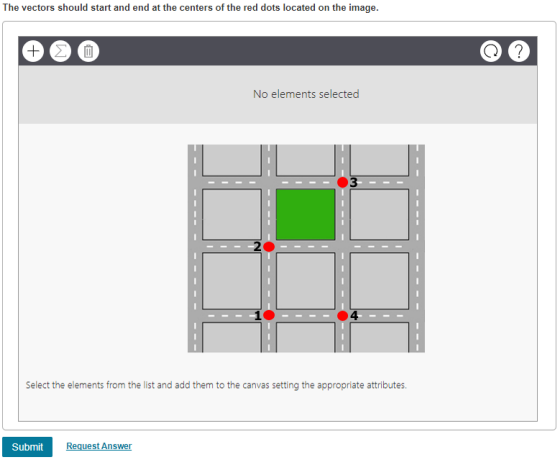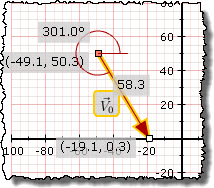solutionVectorMoment
Use the solutionVectorMoment answer type for students to draw vectors and to indicate the direction of any moment provided on the graph.
For accessible vector content: Use the Simple Editorvector moment answer type to create questions for students who use a keyboard or supported screen reader.
Student view (for a vector question)
Formerly, students needed the Flash player to work with vector or moment questions, but now these questions appear to students in an HTML5 tool.

Overview of solutionVectorMoment features
| |
Basic Features |
| Background
|
- You can add a background image on which students can work.
- A grid is in the background. You can determine the scale of the background grid and whether this grid is visible.
- You can create vectors and moments that are initially visible to students. These vectors can either be stuck in place on the background or editable by students. Any moments can later be labeled by students as having clockwise, counterclockwise, or no moment/torque action
|
| Vectors
|
- All vectors must be labeled.
-
You can control the color and width of a vector.
- You control whether the vector length and angle, start point, or end point are visible to students when they add a vector or only by clicking the Attributes button.

-
When students click the Attributes button, they can change the length and angle of a vector, but not its start and end point.

- You can add certain vectors to a vector called "SUM_vec", which is the sum of only those vectors you add to it. You may make the vector sum visible to the students. However, do not make this vector visible if it is not necessary and if not all vectors drawn are to be added to the sum.
-
If students choose to draw "unlabeled" vectors as drawing or analysis aids, these are not graded.
|
| Moments
|
-
You can add a moment for students to identify the direction. Students click once to add a clockwise arrow, again to add counterclockwise arrow, and a third time to return to a state of no moment/torque action (no directional arrow).
-
The grading system checks only whether a student’s answer matches the correct direction of the moment.
|
| Answers
|
-
You can set conditions on each vector drawn by a student to determine whether an answer is correct or not. All conditions must be met in order for an answer to be graded correct.
-
Answer conditions can be placed on the start point, end point, length, angle, or existence of a vector.
|
See also:
Evaluation of student responses
Entering solutionVectorMoment answers
Adding wrong answers
Adding alternate correct answers





